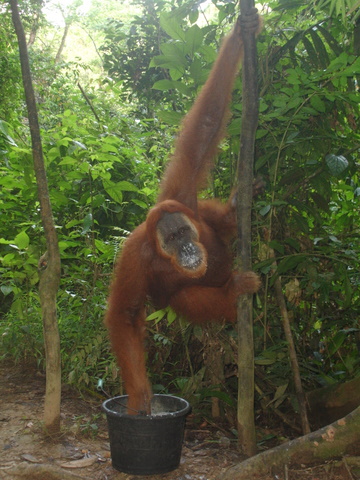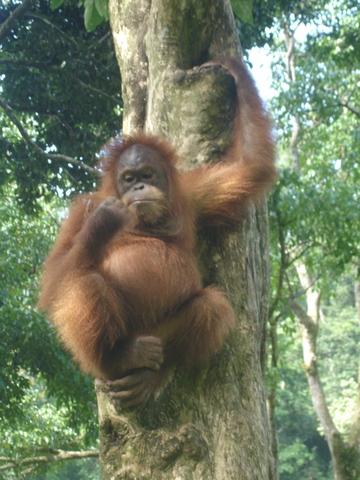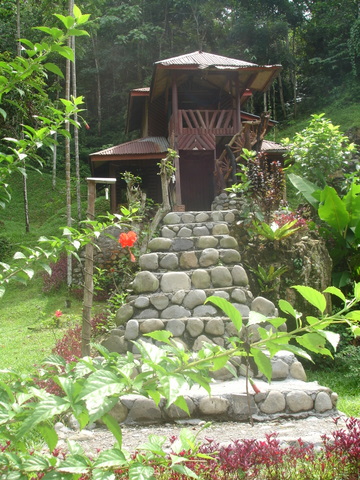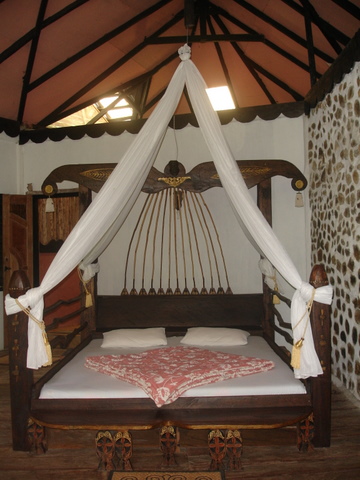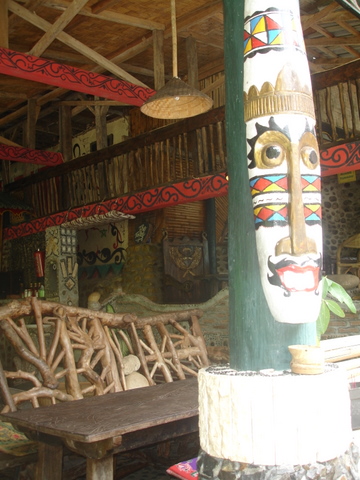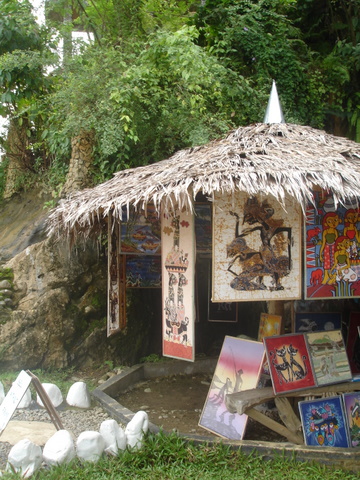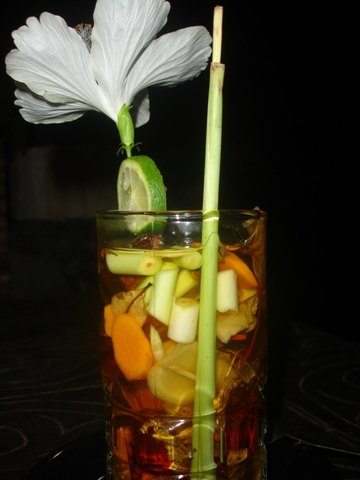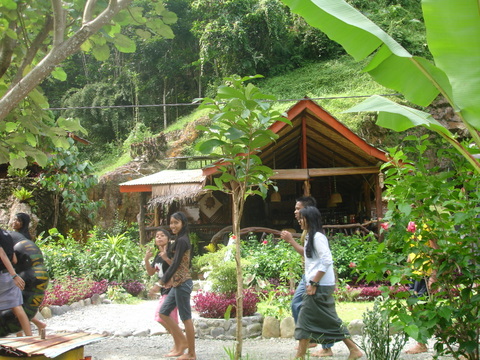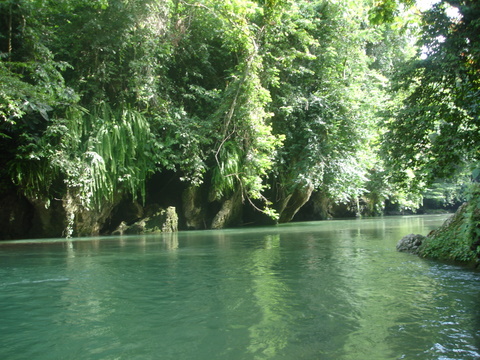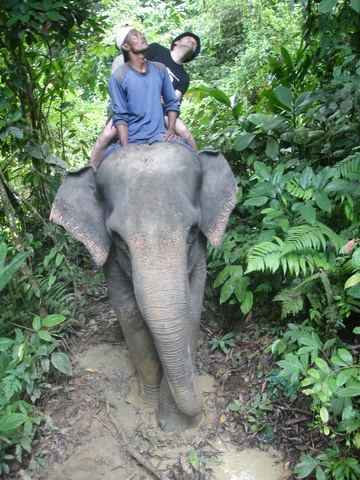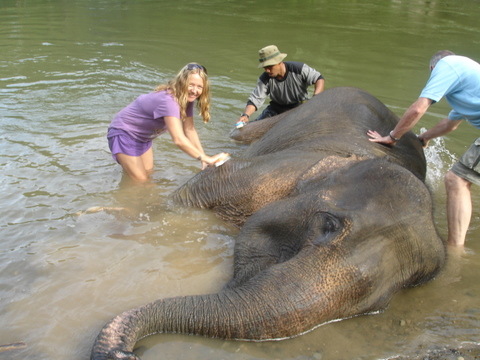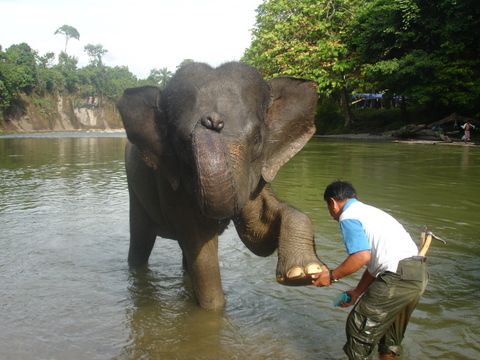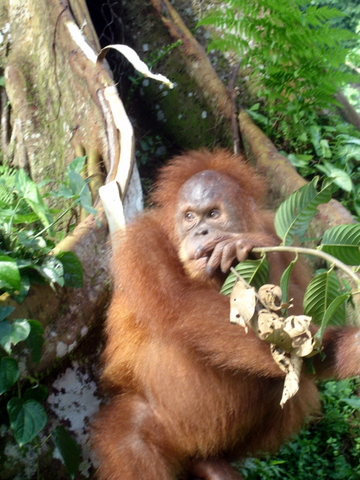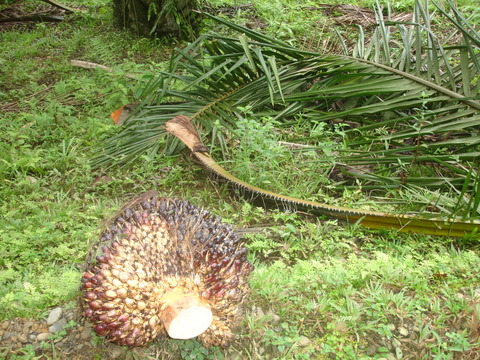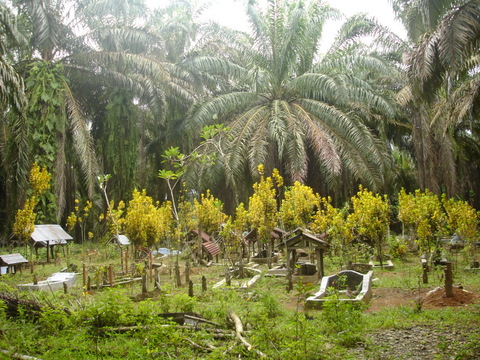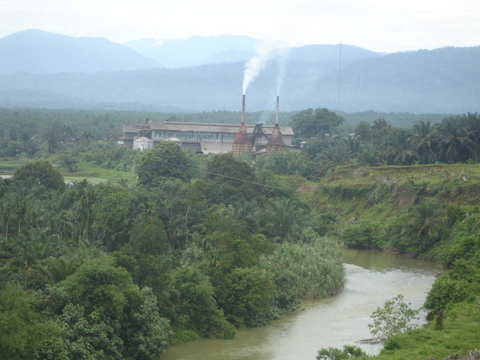The jungle rises steeply in front of us and we cross the river balanced precariously on a dug out canoe. The wall of dense green foliage looks impenetrable but a narrow, muddy trail has been carved out and the ranger leads us to a small clearing and a feeding platform. We only have to wait a couple of minutes before an orangutan comes swinging gracefully through the trees. It’s a female, and her scrawny baby clings on tightly as she stuffs bunches of bananas into her mouth and scoffs handfuls of milk from the rangers bucket.
Gunung Leuser National Park, Northern Sumatra is one of only two places in the world where orangutans can be observed in the wild. The Bohorok rehabilitation centre operated here from 1973 – 2004 and saw 200 orangutans rescued from captivity and reintroduced to the forest, joining the wild population estimated at around 2000. The feeding platform is the last vestige of the program and is a ‘fall back’ for any semi wild orangutans struggling to find food.
Coming back down the trail we see a huge male sprawled across a thick branch and further on another female hanging nonchalantly from a tree trunk. I chat with the ranger who says that he has the best job in the world. He tells me of the day his father died and as he sat weeping in the jungle, an orangutan appeared and embraced him. “Sometimes the orangs are more human than humans,” he says.
When I first visited the park in 2000, volunteers would carry the newest arrivals like backpacks up into the forest to teach them how to find fruit, build nests and even how to climb trees. The furry, comical creatures and the charmingly quirky village of Bukit Lawang captured my heart and I dreamed of returning to work as a volunteer. But one dark November night in 2003, a flash flood sent a 10 meter wave roaring through the valley destroying everything in its wake. The orangutans, high in the trees survived but more than 300 people died that night and much of the village was washed away, including 400 houses, and 35 guest houses. The road to recovery has been long, but five years on Bukit Lawang, quirky as ever, is once again flourishing and these days is far cleaner, more attractive and more environmentally conscious. There is a spirit of renewed hope and I don’t experience the aggressive hustle of last time, instead, as I walk up the river looking for a room people smile and say “Welcome. Thank you for coming”, and I know they mean it.
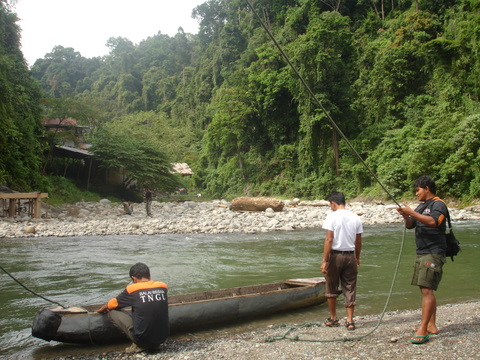 the river seperates Bukit Lawang from the National Park
the river seperates Bukit Lawang from the National Park
The most atmospheric place to stay is at the top of the village, near the entrance to the national park, the guesthouses are thoughtfully constructed, blending seamlessly with the jungle. I stay at Garden Inn, an extraordinarily pretty place filled with tropical blooms, the family is kind and the evenings are candle-lit and filled with the mellow strains of acoustic guitar. I accidentally leave some mangos on my verandah one afternoon and get invaded by a troop of cheeky monkeys who have a bit of a party on my porch! Nearby is the Jungle Inn, where carpenters have been busy weaving the art and form of the jungle into the furniture which is gnarled, twisted and vine like. Tables are carved from single tree trunks and the walls are a mosaic of river pebbles. They call it the ‘go with nature style.’
Late one afternoon I sit by the river, dark thunder clouds tinged with the rosy glow of sunset hang over the forest. A king tree soars majestically above the jungle canopy, according to locals these trees are protected by the spirits of the jungle and almost impossible to chop down. I gaze across the river, scanning for wild life and right on cue, an orangutan emerges through the undergrowth and sits down on a river stone, seemingly lost in thought, until 3 cheeky monkeys start throwing stones. She takes a swipe at them and then ambles back into the trees.
With dramatic scenery, prolific wildlife and plenty of ambience, Bukit Lawang is a really pleasant place to stay for a few days. The river is great for swimming or floating downstream on a tube, there are a number of trails leading into the forest, and the Friday market is buzzing. Local food is fresh, flavorful and wholesome. Dishes are simmered and served up with an array of whole herbs, such as bundles of lemon grass, assorted leaves and sticks of cinnamon. Dadar, a specialty, are green pancakes, naturally coloured by jungle leaves and cooked with brown sugar and coconut. Best of all is the jungle tea, a herbal concoction that is said to be good for stimulating the blood. The Jungle Inn version comes unstrained and swimming in licorice, star anise, various leaves, nutmeg, seeds, and chunks of ginger.
Most tourists go trekking, often spending a night or two in the jungle. Orangutans, monitor lizards, gibbons and monkeys are common sights, but the park is also home to sun bears, tigers and elephants, although these are pretty illusive. A guide is mandatory and those operating out of jungle inn are particularly good. Imbued with the spirit of the jungle they are knowledgeable, responsible and also good fun with many stories to share.
Two days climbing through the steaming jungle seems like a lot of hard work to me ─ An elephant trek sounds infinitely more appealing, and so I find myself heading north to Tangkahan, on a motor bike with Rinto, one of the Jungle Inn guides. He has warned me that the road is bad, but road is too kind a term for what is in fact a muddy, potholed and very bumpy trail. The trip can also be done by 4wd or by a rough bus ride from Medan, but the bike ride is great fun and for three hours we pass through rural villages, forests, rubber plantations and sadly, miles and miles of palm oil plantations – the scourge of the jungle. This is true Frontier country, the rainforests here are considered to be the lungs of the earth, but thousands of acres are cleared annually for palm oil plantations which provide quick, easy money. Locals face a dilemma, save the jungle ─ save the world; Or plant oil palms and feed the family?
The tiny and remote village of Tangkahan is a prime example of grass roots conservation where the community rejected the lure of palm oil and decided instead to set up eco-tourism. We cross the river by raft and make our way to the Jungle Lodge, tantalizingly perched over the river. It is infinitely peaceful here, a true wilderness with just four guesthouses and an elephant camp. Of the seven elephants that live here, three came from Bukit Lawang, emerging from the jungle just days before the flood. They were in a frenzied state and refused to go back. Locals were at a loss as to what to do with them, you cant have wild elephants living in the village, so they were trucked to Tangkahan to join the Conservation Response Unit, which uses elephants to patrol the jungle in search of poachers and illegal loggers. It’s possible to join the four-day forest patrol to Bukit Lawang, but I am happy with a two hour trek.
I ride on Yuni, one of the Bukit Lawang elephants, she is cheeky and playful and her mahout (handler) deftly guides us across rivers, up and down steep muddy slopes and through dense vegetation. Its great to experience the jungle from up high and we stop to sample different fruits and medicinal herbs and leaves. We also see lots of Thomas Leaf monkeys, known as funky monkeys due to their black and white mohawks. Afterwards we wash the elephants in the river. Yuni lies on her side, I swear she is smiling as we scrub off the mud, she then saunters off, disappears underwater and emerges to gleefully squirt us all with trunks full of water. The guides seem to really love their charges and the experience is uplifting, positive and authentic. There are no tacky circus tricks here, although I do get an elephant kiss, when Yuni gently places the tip of her trunk on my forehead, but then Ardana joins in and plants a great big kiss right on my nose, which the guides find hysterical.
I wake early the next morning to birdsong and monkey chatter, my body aches from the bike and elephant rides, so I swim across river to a crevice in the rocks where hot springs bubble up. Completely alone, I soak in the therapeutic waters and soak up the tranquility, until Rinto arrives with a tube and we walk upstream to a gorge and a picturesque waterfall where I get a jungle massage from the pummeling water. We then drift gently downstream on the tube, stopping at Pantai kupu kupu (butterfly beach). Rinto tells me that if a butterfly lands on you it will bring great luck, but as I sit by the river in this hidden paradise, with hundreds of brightly coloured butterflies and dragon flies flitting around me, I already feel incredibly lucky.
About orangutans
Millions of orangutans once roamed the forests that stretch from China to Java, now they can only be found in small pockets of Borneo and Sumatra and their very existence lies under grave threat. In the last 2o years the Sumatran population has decreased from 12,000 to an estimated 6500 and has been classified as “Critically Endangered” by the IUCN, the World Conservation Union.
The Pet trade
Although protected by legislation dating from 1931, which prohibits the owning, killing, or capture of orangutans, they are still in high demand for the pet trade. A baby orangutan can fetch up to $500 in Jakarta and $5000 in Taiwan. A common method for capturing a baby is to track a mother, fell the tree she is in then shoot or club her to death. Environmentalists say that for every orangutan in captivity at least three babies and their mothers have been killed by poachers or died from mistreatment. Orangutans breed more slowly than any other primate, with the female producing a baby on average only once every 7-8 years. A female will usually have no more than 3 offspring in her lifetime which means that orangutan populations grow very slowly, and take a long time to recover from habitat disturbance and hunting.
Shrinking habitat
It is estimated that the huge forest fires that swept though Indonesia in 1997 destroyed at least 30% of their habitat and drove orangutans to villages where they became easy prey for poachers. Clear felling for rice paddies, rubber plantations and the valuable hardwood trade also forces orangutans out of the forest in search of food. Deemed as agricultural pests by plantations owners, they are often killed.
Indonesia has one of the highest tropical forest loss rates in the world; an estimated 70% of Sumatran forest cover has now been decimated. The Indonesian government admits that the rampant destruction of its forests, estimated at over two million hectares a year has been an ecological and conservation disaster, yet illegal logging and forest conversion remain out of control. Many blame over-logging for the flash flood that devastated Bukit Lawang.
Palm Oil, the biggest threat of all
Now, orangutans face the gravest threat of all and that is an insatiable global demand for palm oil, a popular vegetable oil used in many food products, as well as cosmetics and increasingly in bio fuel. Ninety per cent of the world’s palm-oil exports come from the plantations of Malaysia and Indonesia. The low land forests of Borneo and Sumatra – the last remaining habitats for orangutans, are the areas favored for conversion. Over 80% of the land that has been deforested in Sumatra over the last 20 years can be attributable to the planting of palm oil and all unprotected low lying forest is at risk.
oil palm fruit
Growing palm oil is a lucrative business and the price of crude palm oil has risen steadily. Impoverished land owners see few financial alternatives and many give up their land to become small-holders or to work on the plantations.
oil palms towering over a cemetery
The problem with bio fuel
The biggest irony is the use of palm oil for bio fuel, a supposedly ‘green’ fuel, which has been heralded as a low carbon solution to climate change. Rainforests in some of the worlds most biodiverse eco systems are being clear felled at an alarming rate and replaced by oil palms. This quest for green fuel is actually causing more damage to the climate than the fossil fuels it was designed to replace. The European Union has set targets for ten per cent of all transport fuel to come from crops by 2020. Currently, over seven million hectares in Sumatra are utilized as oil palm plantations, and the plan is to extend this by a further 20 million hectares. Fires are used to clear the land, and peat bogs are drained to plant oil palms, a process which releases hundreds of millions of tonnes of carbon dioxide, making Indonesia the third highest contributor of CO2 emissions in the world. Environmentalists claim that currently, more carbon emissions result from deforestation and peat fires than are produced by the entire global transport sector. When a hectare of primary rainforest is cleared it releases around 65 times as much carbon into the atmosphere as can be saved annually by using the palm oil as a bio fuel.
A palm oil processing plant
The use of palm oil in itself is not the problem; the problem lies in the destruction of primary rainforest to grow the oil palms. There is plenty of degraded land available in Sumatra and Borneo, but palm oil companies can increase their profits by cutting down rainforest and selling the timber. The international community needs to demand that oil-palm concessions are not granted in forested areas, and that local retailers and manufacturers only source their palm oil from non-destructive plantations.
What about us?
The thing is its not just about animal lovers and conservationists wanting to ‘save the cute furry animals’. Yes, they are incredibly endearing and anyone who has ever had a close encounter with an orangutan can testify to what a magical experience it is, but the orangutans are just the tip off the iceberg. They are recognized as a “keystone” species for conservation, as they play an important part in forest regeneration through the fruit and seeds they eat. If they become extinct there will be a knock-on effect on thousands of other species. Including humans, because we cannot survive without the oxygen created by the rainforests.
There is nothing quite like breathing the pure air of the rainforest, experiencing its silence and being imbued with its special energy. My time in Sumatra has inspired me to do everything I can to preserve these rainforests. One step at a time, one word at a time, it might not be much but its something. If this story has inspired you, check the following websites to see what you can do.
SOS Sumatran Orangutan Society
The key lies in education and SOS, the Sumatran orangutan society runs a number of programs to this end, claiming, “The success of orangutan conservation in Indonesia lies in the hands of the local people”. Their aim is to empower the next generation of Indonesian conservationists through grass roots projects focusing on wildlife conservation. Programs include: Restoring deforested land: Touring educational road shows: The development of a conservation curriculum for schools in North Sumatra: Community forestry schemes to reinforce national park buffer zones and provide sustainable alternative incomes for people living adjacent to natural orangutan habitat: As well as a tree planting program that has seen the planting of over a quarter of a million indigenous tree seedlings to date.
http://www.sumatra-indonesia.com/tangkahan.htm
http://www.bootcampsumatra.com
ran.org/the_problem_with_palm_oil/
www.greenpeace.org.uk/forests/palm–oil

